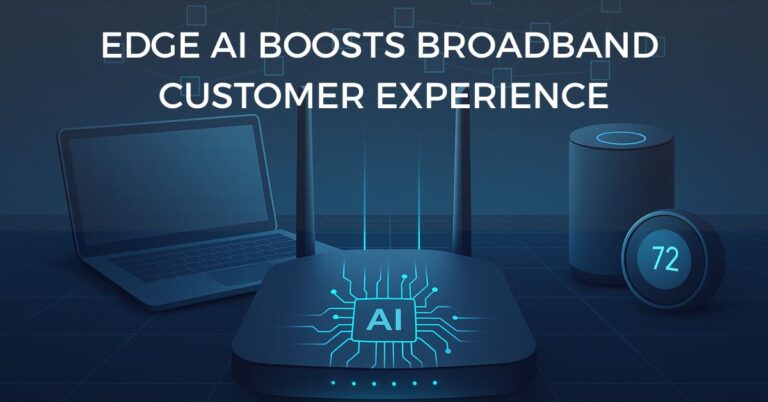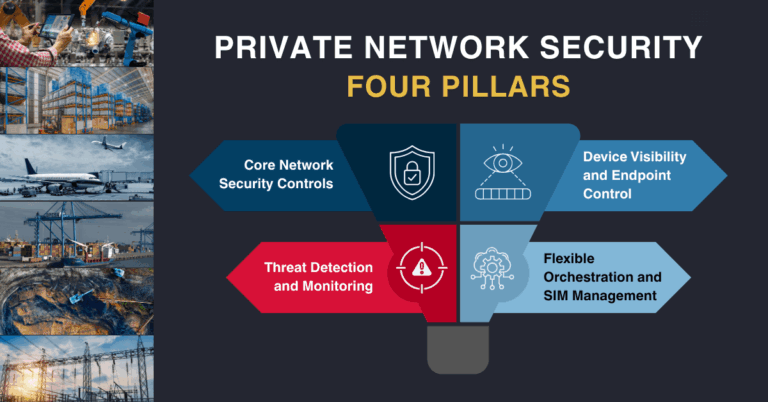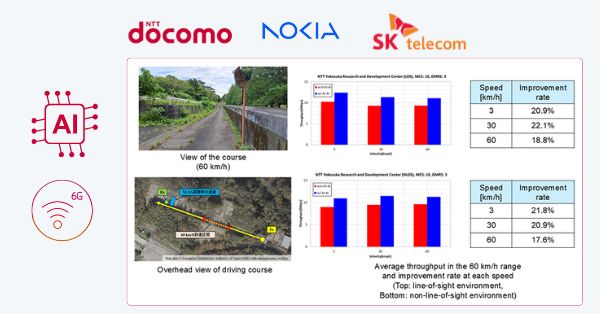Today’s broadband customers expect more than just speed. They want seamless Wi-Fi, instant support, proactive issue resolution, and secure, personalized experiences. To meet these expectations, providers are turning to a transformative technology: Edge AI.
Unlike traditional AI that operates exclusively in massive data centers, Edge AI brings intelligence directly to devices at the network’s edge, such as home routers, IoT gadgets, and mobile devices. This shift is set to revolutionize how broadband networks operate and how customers experience connectivity.
Understanding Edge AI for Broadband Networks
At its core, Edge AI means running AI algorithms on local devices instead of relying solely on cloud servers. By processing data closer to where it’s generated, Edge AI reduces the delay (latency) in decision-making.
For instance, your smart speaker recognizing your voice command instantly, even without an internet connection, is Edge AI at work. The AI model for basic commands is stored locally; cloud AI kicks in only for more complex tasks.
In broadband, this same principle empowers routers, Wi-Fi extenders, and IoT hubs to diagnose issues, optimize performance, and interact with customers directly and intelligently.
How Edge AI Enhances Broadband Customer Experience
1. Proactive Self-Diagnosis and Troubleshooting
Traditionally, broadband troubleshooting involves frustrating calls and wait times. Edge AI changes this. A smart router embedded with AI can:
- Continuously monitor connection quality.
- Detect signal interference or weak spots.
- Automatically reconfigure channels or suggest router relocation.
- Engage users via voice or app-based prompts with step-by-step fixes.
2. Conversational AI for Real-Time Support
Edge AI allows devices to engage in natural conversation without needing to trigger wake words like “Hey Siri.” This means:
- Customers can talk to their router naturally: “Why is my internet slow?”
- The router understands, runs local diagnostics, and responds instantly.
- If needed, it escalates to cloud AI or human support, handing off context seamlessly.
Charter Communications, for example, uses AI that listens to customer calls in real time and suggests best solutions to agents — or even resolves issues automatically, reducing the need for large call centers.
3. Personalized Wi-Fi and Smart Device Management
Modern homes are packed with devices: smart TVs, gaming consoles, security cameras, and dozens of IoT sensors. Edge AI ensures each device gets the right bandwidth and priority.
Capabilities include:
- Learning household usage patterns.
- Allocating bandwidth dynamically during peak use (e.g., video calls vs. streaming).
- Suggesting optimal times for software updates or large downloads.
- Manages IoT devices efficiently.
This transforms Wi-Fi from a static utility into an intelligent, adaptive service.
Edge AI vs Cloud AI in Broadband Applications
Here’s how Edge AI stacks up against Cloud AI for broadband applications:
| Aspect | Edge AI | Cloud AI |
|---|---|---|
| Latency | Ultra-low, real-time | Higher due to data transfer delays |
| Connectivity Dependence | Works offline for core tasks | Requires stable internet |
| Privacy | Higher, data stays local | Data sent to remote servers |
| Processing Power | Limited by device hardware | Scalable, virtually unlimited |
| Use Cases | Real-time troubleshooting, smart Wi-Fi, local voice commands | Big data analytics, predictive maintenance, long-term insights |
Comcast Janus: Edge AI in Action
A leading example of Edge AI’s impact is Comcast’s Janus initiative:
- Virtualized Core: Janus replaces legacy hardware with software-defined functions managed at the edge cloud.
- AI/ML-Powered Self-Healing: Real-time telemetry identifies faults and reroutes traffic automatically, ensuring minimal disruption during outages or peak loads.
- Live Sports Streaming: With data usage surging, especially for 4K live sports, Janus dynamically scales bandwidth, ensuring fans never miss a moment.
By integrating AI from core to edge, Comcast provides speed, reliability, and sustainability, aiming for carbon neutrality by 2035.
Edge AI and the Growing AI Traffic
According to Nokia Bell Labs, global AI traffic is projected to grow by 24% CAGR, reaching over 1,000 exabytes/month by 2030. This includes:
- Direct AI Traffic: Real-time interactions like XR, autonomous operations, or smart assistants.
- Indirect AI Traffic: AI-driven recommendations that increase video and content consumption.
This shift demands broadband edges that guarantee performance. Nokia’s Multi-Access Gateway (MAG) addresses this by combining fiber, 5G, and FWA, with embedded edge compute, DDoS defense, and network slicing.
Industry-Wide Use Cases Beyond Broadband
Edge AI’s principles are tested and proven in other industries:
| Industry | Edge AI Application |
|---|---|
| Healthcare | Wearables providing live health stats; smart hospital instruments |
| Automotive | Tesla’s on-board AI for self-driving decisions |
| Retail | Smart shelves auto-alerting staff for restocks |
| Energy | Local AI for solar panel optimization |
| Aviation | Offline maintenance AI in hangars |
Securing the Edge: A Critical Priority
A more intelligent edge also attracts cyber threats. DDoS attacks are rising, up 166% year over year, with IoT botnets behind 60% of attacks.
Solutions like Nokia Deepfield Defender use AI to detect and mitigate attacks in real time, filtering malicious traffic at the edge without impacting legitimate users. Providers must embed such defenses to maintain trust and uptime.
Edge AI in Smart Homes and IoT
Edge AI enhances the entire smart home ecosystem.
- Smart thermostats, lights, and security cameras can coordinate with routers for optimal performance.
- Local AI ensures devices function smoothly even during network outages.
- Enables new services like home health monitoring or energy optimization.
Sustainability and Energy Efficiency
Processing locally reduces repeated cloud traffic, cutting energy use.
- Edge AI devices require less power than constant cloud communication.
- Supports green initiatives; for example, Comcast aims for carbon neutrality by 2035.
This aligns technology upgrades with sustainability goals.
Overcoming Deployment Challenges
Despite high promise, 90% of companies feel their edge strategies are still maturing. Key roadblocks:
- Data complexity: Massive, real-time streams from multiple sources.
- Infrastructure complexity: Upgrading legacy networks with edge compute.
- Skills gap: Need for AI, network security, and edge orchestration expertise.
- Operational silos: Aligning IT and OT teams for unified edge deployment.
Solution: A converged edge platform that simplifies rollouts, secures traffic, and manages diverse access technologies.
Detailed Implementation Roadmap
How can broadband providers adopt Edge AI step by step?
- Assess Use Cases: Start with customer pain points like Wi-Fi drops or slow speeds.
- Choose Pilot Devices: Upgrade routers with embedded AI chipsets.
- Integrate with Cloud: Use cloud AI for long-term analytics, keep real-time tasks local.
- Ensure Security: Deploy DDoS protection, local encryption.
- Train Staff: Cross-skill teams for hybrid AI management.
- Measure Impact: Use clear KPIs for speed, uptime, and resolution times.
Financial Impact
Edge AI boosts ARPU and lowers OPEX.
- Fewer support calls reduce customer service costs.
- Proactive fixes mean fewer truck rolls for on-site repair.
- Premium services like intelligent Wi-Fi or security bundles can drive upsell.
Customer Case Study Example
Family Scenario:
- Jane works from home, kids game online.
- Router detects congestion, prioritizes Jane’s video calls.
- When the kids complain about lag, the router suggests switching gaming hours or adding a mesh extender.
- Jane never calls support; her smart router handles it all in real time.
Key Metrics to Track
Providers should monitor:
- Average resolution time per issue.
- Reduction in call center volume.
- Customer satisfaction scores (NPS).
- AI-powered auto-fix rates.
- Energy savings per household.
These prove ROI for Edge AI investments.
Key Takeaways for Broadband Providers
Start Small, Scale Smart
- Pilot Edge AI in customer routers for troubleshooting.
- Expand gradually to smart Wi-Fi management and real-time personalization.
Combine Edge with Cloud
- Use edge AI for latency-critical tasks.
- Leverage cloud AI for large-scale analytics and long-term insights.
Secure by Design
- Integrate real-time DDoS detection and mitigation.
- Enforce botnet protection and strong data privacy controls.
Educate and Upskill
- Train staff to manage hybrid AI architectures.
- Cross-train network, IT, and cybersecurity teams for operational resilience.
Partner Strategically
- Work with trusted technology vendors for scalable, cost-effective deployments.
- Evaluate multi-vendor solutions for hardware, software, and orchestration flexibility.
Future Outlook: From Connectivity to Cognitive Service
In the near future, broadband will evolve from simple bandwidth delivery to intelligent, adaptive connectivity that continuously learns and optimizes for each customer. Expect to see:
- Routers and gateways that self-diagnose and repair issues without human intervention.
- Networks that automatically adapt to each device and usage pattern in the household.
- Services that anticipate user needs and provide personalized support proactively.
Providers who master this transformation, blending Edge AI, robust broadband architecture, and strong security, will set themselves apart in an increasingly competitive market.
Conclusion
Edge AI is more than a technology trend — it is a fundamental shift in how broadband providers deliver value. Smarter Wi-Fi, resilient self-healing networks, and personalized services are becoming standard expectations in a connected world.
Leading operators like Comcast and Charter demonstrate that Edge AI drives better customer satisfaction and operational efficiency. With innovative solutions from leading industry vendors, the journey toward an intelligent, secure, and customer-focused broadband edge is not just possible, it’s happening now.
For providers ready to deliver next-generation broadband experiences, the time to embrace Edge AI is today, because your customers already expect tomorrow.








































